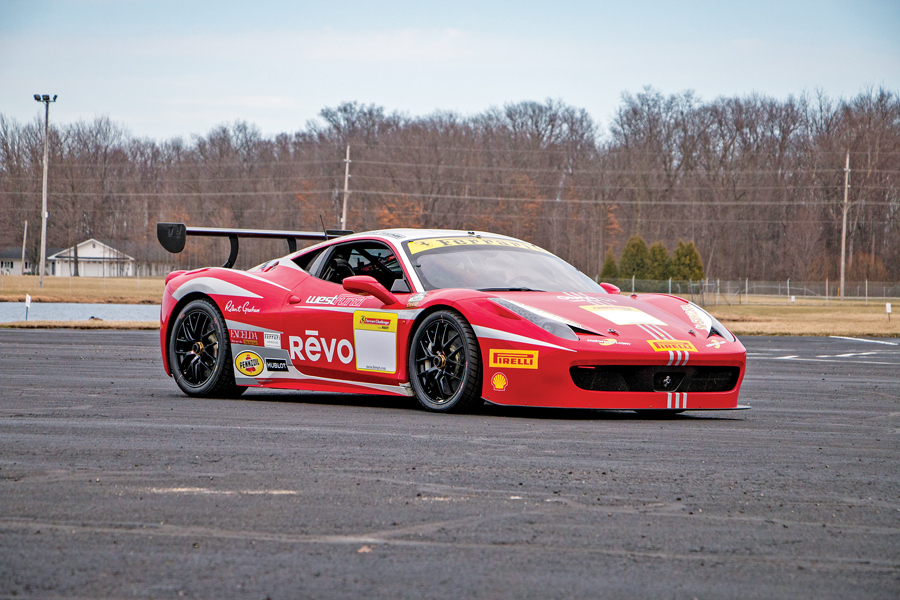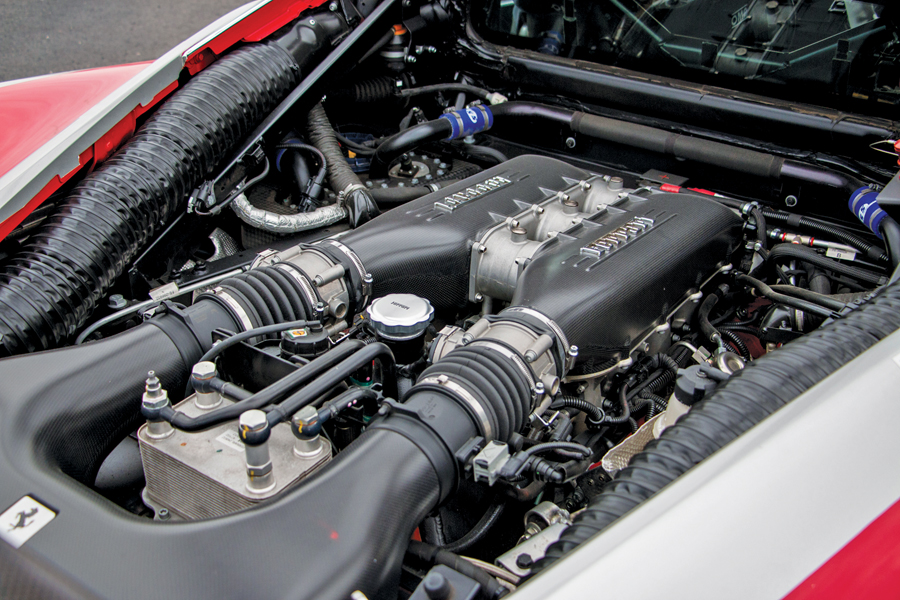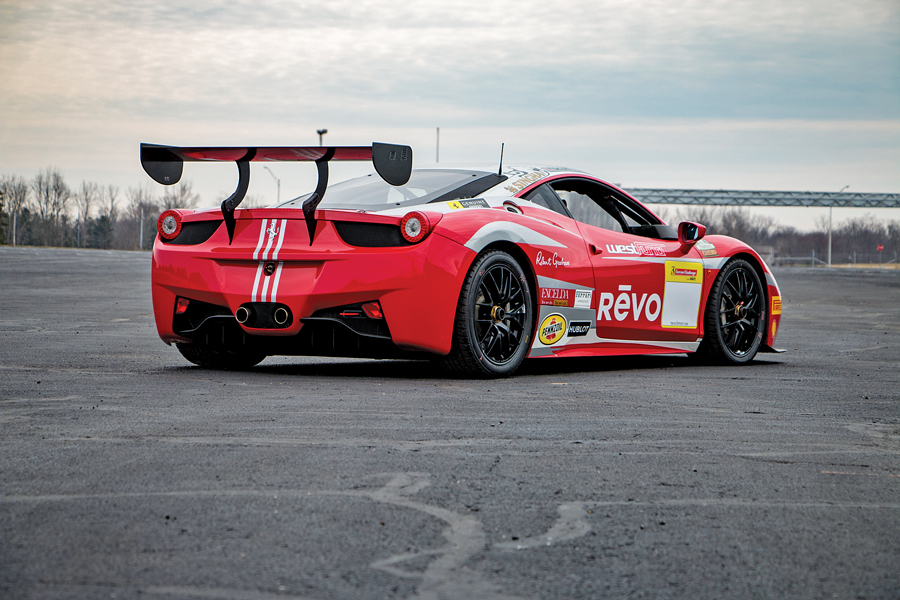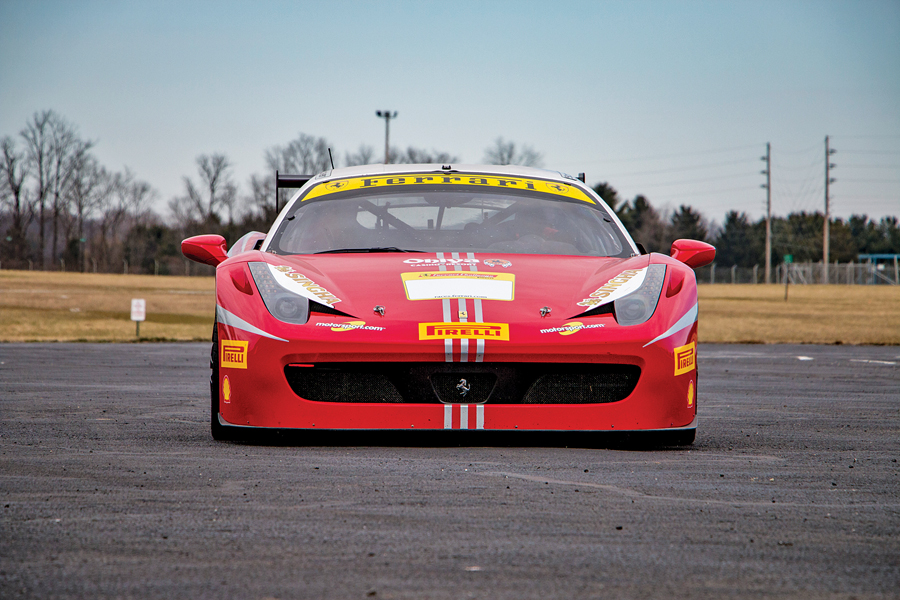- 1/23/2014: 1st Overall at the Ferrari Challenge, Race 1, Daytona International Speedway, Daytona, FL, USA
- 1/24/2014: 11th Overall at the Ferrari Challenge, Race 2, Daytona International Speedway, Daytona, FL, USA
- 1/11/2014: 4th Overall at the Ferrari Challenge, Race 1, Circuit of the Americas, TX, USA
- 2/11/2014: 2nd Overall at the Ferrari Challenge, Race 2, Circuit of the Americas, TX, USA
- 4/12/2014: 4th Overall at the Ferrari Challenge World Finals, Heat 1, Yas Marina Circuit, Abu Dhabi, UAE
- 4/12/2014: 8th Overall at the Ferrari Challenge World Finals, Heat 2, Yas Marina Circuit, Abu Dhabi, UAE
- This car also ran in other Ferrari Challenge World Finals races during 2014 and 2015
SCM Analysis
Detailing
| Vehicle: | 2012 Ferrari 458 Challenge |
| Years Produced: | 2010–15 |
| Number Produced: | Unknown |
| Original List Price: | About $300,000 |
| SCM Valuation: | $198,000 |
| Tune Up Cost: | $3,500 |
| Chassis Number Location: | Left side of dash near windshield |
| Engine Number Location: | In the V of the engine towards the rear on the right |
| Club Info: | Ferrari Club of America |
| Website: | http://www.FerrariClubofAmerica.net |
| Alternatives: | 2014 Lamborghini Huracán LP 620-2 Super Trofeo, 2005 Maserati Trofeo coupé, 2014 Porsche GT3 Cup Challenge |
| Investment Grade: | C |
This car, Lot 495, sold for $198,000, including buyer’s premium, at Auctions America’s Fort Lauderdale, FL, auction on April 1, 2017.
The Ferrari Challenge has outlasted all current single-make racing series, and it may be the longest single-make series ever.
The series was founded in 1993 under Luca Montezemolo’s leadership. Its purpose was to give Ferrari clients an opportunity to experience a Ferrari street car in a competition environment.
The non-stated purpose was to help move some excess inventory.
The first Challenge models were 348s. Standard-production 348s were modified for Challenge racing by installing a kit available from Ferrari’s parts department. Ferrari also built a special 348 Challenge model.
The street-legal 348 Challenge was delivered with a crate of parts to convert it to a Challenge race car. The plan was that a franchised dealer would support a client’s car. The car would be showroom stock with modifications limited to safety items. Ideally, Challenge cars would be equal in performance, making the Challenge a driver’s series.
Paying big bucks to play
While Ferrari dealers were supposed to service and support Challenge cars, the implementation of that intention was open to interpretation.
Getting the most performance out of a showroom-stock race car is an art. Dealers with racing experience soon found advantages, and their cars excelled on the track. Other dealers made backdoor arrangements with racing shops to support their car under the dealership banner.
Serious racers took notice — and began sending their cars to the dealers with the best programs.
Going fast wasn’t the only thing that mattered to racers. Dealers quickly caught on that top caterers, fancy trucks and RV accommodations for downtime attracted free-spending clients.
The Challenge concept proved quite popular, and top teams filled their trucks with clients.
How fast do you want to go? How much do you want to spend? Every racer knows that saying. Challenge racing sets the bar.
Today, a car and support will run over $500,000 the first season. Subsequent seasons will run about $250,000 — if the car doesn’t get wrecked. Sponsorship can help defray costs, but sponsors for a non-televised series can be elusive.
Challenge racing isn’t for someone on a budget.
A serious racing machine
The 458 Challenge was the fifth generation of Ferrari’s Challenge racers.
Each generation evolved further from a street car to a serious racing machine. The 458 Challenge made that point clear.
The 458 Challenge started out as a standard 458 unibody, and from there it gets its own identity. The Challenge body panels are thinner alloy. The windows are Lexan, and carbon fiber is used wherever possible in an effort to shed weight. The brakes are carbon-ceramic for light weight and superior stopping. Rubber suspension mounts are replaced with racing uniballs and alloy shock absorbers replace the stock units.
The car features a stock 570-hp 4.5-liter 458 engine. The engine revs to 9,000 rpm. The Challenge driveline is mapped to produce more torque at lower rpms than the street version, which makes it more manageable in racing applications.
Electronic wizardry in the way of a F1 transmission, traction control, ABS brakes and an adaptive differential complete the package. The 458 Challenge was the most potent V8 Ferrari made up to its time.
Spending, racing and winning
Auctions America’s 458 Challenge comes with quite a story. It came from the stable of Scott Tucker’s Level 5 Motorsports.
Tucker ran an empire of finance companies that generated huge revenues. Reportedly, over $30 million of Tucker’s company’s money got funneled to his racing passion through Level 5 Motorsports.
Tucker and Level 5 seemed to be at every event where cars raced. Over very few years, they racked up a class win at the 2014 24 Hours of Daytona and four consecutive American Le Mans Series team championships. They also finished 3rd in class at the 24 Hours of Le Mans, scored multiple SCCA wins and took several Ferrari Challenge victories.
Talent was a factor in Tucker’s success, but money pushed them over the line. Few teams ever burned through cash like Level 5. They had the best cars, the best engineers and the best equipment.
They reportedly showed up for SCCA races equipped like Penske at the Indianapolis 500.
The party is over
Level 5 Motorsports came to a screeching halt last year after a Federal Trade Commission investigation of Tucker’s companies. It seems that much of Tucker’s fortune was made from payday loans — a predatory practice that charges beyond-usury interest for small loans.
Tucker’s scheme involved domiciling his companies on Native American land to insulate him from federal banking law. The FTC didn’t see things Tucker’s way — and shut him down with a $1,301,897,652 judgment. That’s right, Tucker’s on the hook for One Billion Dollars.
The judgment effectively shut down Level 5 Motorsports. Their assets have been on the market for much of the past year, but not much sold.
Apparently, someone wanted the liquidation sped up. With the oversight of a court-appointed monitor, Level 5’s cars and equipment were consigned to Auctions America. More than 350 lots were offered, including 11 very cool race cars, a truly impressive transporter, top-shelf track support gear, spare parts, and assorted shop tools and machinery.
Right on the money — but no more races
Our subject 458 Challenge was one of six Ferrari race cars offered.
It was last used in early 2015, when it was lightly crashed and retired. It has been repaired and looked to be in good condition. Auctions America’s sparse description said nothing about spares or time on the engine.
Auctions America’s estimates on Level 5’s assets were quite reasonable, so the auction was well attended. This was stuff few people need, so prices were low but fair. Anyone expecting a fire sale was disappointed.
The Challenge car sold right on the money. It wasn’t a championship car, and it was well used, so no premium was expected.
It was never crashed hard, so no discount was expected, either.
Other 458 Challenge cars on the market are being offered at similar prices when adjusted for condition. Remember, these are not street-legal Ferraris. The sale price here was not far off what a standard 458 would sell for.
Interestingly, there are a couple folks who are assembling Challenge car collections. Many of the Challenge cars were rode hard and put away wet. Authentic early examples are quite difficult to find.
This car’s competitive life is over. It has an interesting history, and it would be a prime target for a collector. Whoever got it bought a good car at a fair price. ♦
(Introductory description courtesy of Auctions America.)



